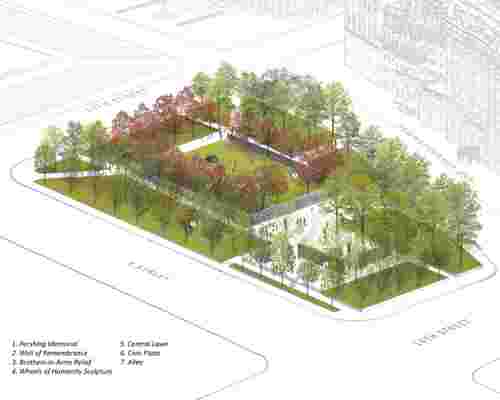Washington, D.C., is a city of monuments and memorials. Tourists from near and far travel to the U.S. capital to dive deep into American history, to surround themselves with politics, and to pay homage to those who have sacrificed their lives for the country. With no shortage of monuments dedicated to historical figures and war casualties, it may seem odd that there is no national memorial for the Americans who fought and died in World War I. A Congressional committee was established in 2013 to oversee the centennial remembrance of American involvement in WWI. After a worldwide competition, the commission has chosen a design for a WWI memorial crafted by architect Joe Weishaar and sculptor Sabin Howard, which would open in time for the 100th anniversary of Armistice Day in November 2018.
Called “The Weight of Sacrifice,” the memorial will transform Pershing Park, a square-block park just steps from the White House. Like other memorials in D.C., this one will feature walls carved with bas-relief images: Displayed here will be scenes of soldiers performing their duties in the Great War. In the center of the park’s lawn will stand a sculpture by Howard.

A rendering of the site.
The plan, however, still faces many obstacles. It must be approved by the National Park Service and be evaluated for environmental impact and historical preservation. Concerns have been expressed by several agencies that must, at least in part, approve the project: the Commission of Fine Arts, the National Capital Planning Commission, and the District of Columbia State Historic Preservation Office. In fact, the design has caused some controversy. Pershing Park is not on the National Register of Historic Places, and some—notably the Cultural Landscape Foundation—have argued that construction of the monument would prevent the square from earning a protected historic status. The design, as it is proposed, would require a massive overhaul of the outdoor space.
Assuming it clears the necessary bureaucratic hurdles, the plan may still change considerably before any ground breaking. With a little over a year until the beginning of centennial events, there’s plenty of time for design reworks.
